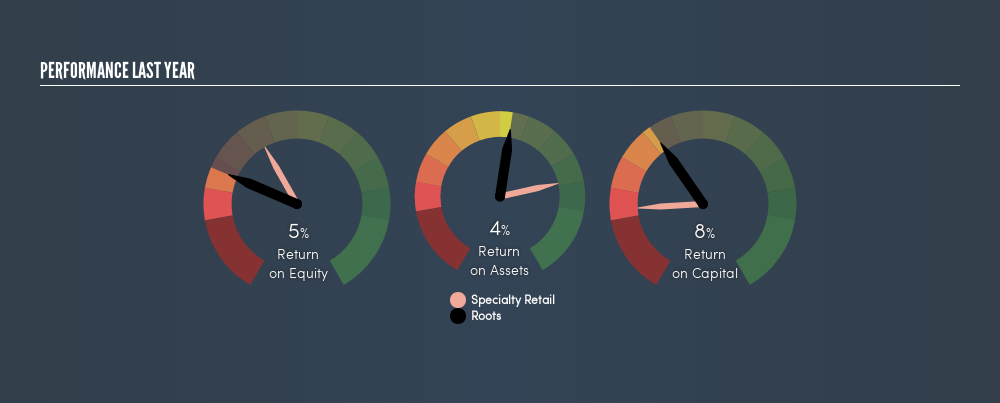- Canada
- /
- Specialty Stores
- /
- TSX:ROOT
Why We’re Not Keen On Roots Corporation’s (TSE:ROOT) 7.8% Return On Capital

Want to participate in a short research study? Help shape the future of investing tools and you could win a $250 gift card!
Today we'll look at Roots Corporation (TSE:ROOT) and reflect on its potential as an investment. Specifically, we'll consider its Return On Capital Employed (ROCE), since that will give us an insight into how efficiently the business can generate profits from the capital it requires.
Firstly, we'll go over how we calculate ROCE. Then we'll compare its ROCE to similar companies. And finally, we'll look at how its current liabilities are impacting its ROCE.
Return On Capital Employed (ROCE): What is it?
ROCE is a metric for evaluating how much pre-tax income (in percentage terms) a company earns on the capital invested in its business. Generally speaking a higher ROCE is better. Ultimately, it is a useful but imperfect metric. Renowned investment researcher Michael Mauboussin has suggested that a high ROCE can indicate that 'one dollar invested in the company generates value of more than one dollar'.
So, How Do We Calculate ROCE?
The formula for calculating the return on capital employed is:
Return on Capital Employed = Earnings Before Interest and Tax (EBIT) ÷ (Total Assets - Current Liabilities)
Or for Roots:
0.078 = CA$26m ÷ (CA$381m - CA$52m) (Based on the trailing twelve months to February 2019.)
So, Roots has an ROCE of 7.8%.
Check out our latest analysis for Roots
Is Roots's ROCE Good?
One way to assess ROCE is to compare similar companies. Using our data, Roots's ROCE appears to be significantly below the 10% average in the Specialty Retail industry. This performance is not ideal, as it suggests the company may not be deploying its capital as effectively as some competitors. Setting aside the industry comparison for now, Roots's ROCE is mediocre in absolute terms, considering the risk of investing in stocks versus the safety of a bank account. It is possible that there are more rewarding investments out there.
In our analysis, Roots's ROCE appears to be 7.8%, compared to 3 years ago, when its ROCE was 0.8%. This makes us think the business might be improving.

It is important to remember that ROCE shows past performance, and is not necessarily predictive. ROCE can be deceptive for cyclical businesses, as returns can look incredible in boom times, and terribly low in downturns. ROCE is, after all, simply a snap shot of a single year. Future performance is what matters, and you can see analyst predictions in our free report on analyst forecasts for the company.
What Are Current Liabilities, And How Do They Affect Roots's ROCE?
Current liabilities are short term bills and invoices that need to be paid in 12 months or less. Due to the way ROCE is calculated, a high level of current liabilities makes a company look as though it has less capital employed, and thus can (sometimes unfairly) boost the ROCE. To check the impact of this, we calculate if a company has high current liabilities relative to its total assets.
Roots has total liabilities of CA$52m and total assets of CA$381m. Therefore its current liabilities are equivalent to approximately 14% of its total assets. This is a modest level of current liabilities, which would only have a small effect on ROCE.
Our Take On Roots's ROCE
If Roots continues to earn an uninspiring ROCE, there may be better places to invest. You might be able to find a better investment than Roots. If you want a selection of possible winners, check out this free list of interesting companies that trade on a P/E below 20 (but have proven they can grow earnings).
If you are like me, then you will not want to miss this free list of growing companies that insiders are buying.
We aim to bring you long-term focused research analysis driven by fundamental data. Note that our analysis may not factor in the latest price-sensitive company announcements or qualitative material.
If you spot an error that warrants correction, please contact the editor at editorial-team@simplywallst.com. This article by Simply Wall St is general in nature. It does not constitute a recommendation to buy or sell any stock, and does not take account of your objectives, or your financial situation. Simply Wall St has no position in the stocks mentioned. Thank you for reading.
About TSX:ROOT
Roots
Designs, markets, and sells apparel, leather goods, footwear, and accessories under the Roots brand in Canada and internationally.
Excellent balance sheet and fair value.
Market Insights
Community Narratives



